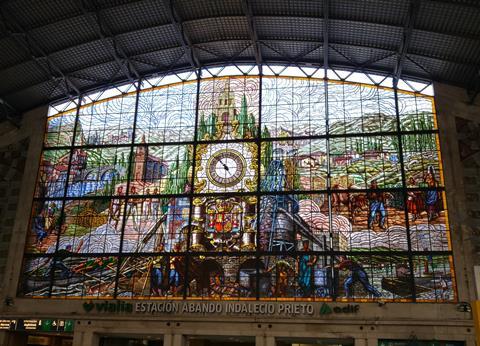
SPAIN: The Ministry of Transport, Mobility & the Urban Agenda has published details of its ‘Informative Study’ for a new railway line between Santander and Bilbao.
Prepared by WSP Spain-Apia and Sener Ingeniería y Sistemas under a €1∙2m contract awarded in September 2020, the study puts forward six alternative routes. All would offer journey times of around 1 h between Santander and Bilbao compared with about 3 h on the existing 120 km metre gauge line linking the two cities, which is partially electrified at 1∙5 kV DC. For comparison, buses on the coastal motorway take just 1 h 15 min non-stop and 1 h 30 min with intermediate calls.
Passenger traffic over the new line is estimated at around 2∙43 million trips a year, but there is no mention of freight, even though the line would form part of the Cantabro-Mediterráneo freight corridor.
The terrain through which the line would pass includes large areas of cave-ridden limestone, requiring numerous tunnels and viaducts. The proportion of tunnel and viaduct varies between 64% and 71%.
Given the need to pass north of Peña Cabarga to protect the landscape in the Pas River valley and the salt marshes to the southeast of Santoña, the authors favour options A1 and C1; A1 offers the best internal rate of return at 1∙89%.
None of the options takes account of traffic potential in the area between Astillero, Ajo and Noja, where urban development has taken place since the 1990s. Nor is there provision for stations serving the market towns of Solares and Ampuero, while bypassing Laredo to the south means missing another potentially large source of traffic, especially in summer.
The study includes an assessment of technical and environmental feasibility, but a second phase of work will include a definitive environmental impact study.
A third phase of work will provide public information and an environmental assessment of the chosen route, leading to its final approval.
Six route options in Informative Study
A1: 63 min, €2∙02bn. Leaving the Santander – Palencia line west of Guarnizo, the proposed route turns through 180º and then follows the metre gauge line to the north of Solares to reach a new station serving Colindres and Laredo on the right bank of the Asón River. It then continues east, mostly in tunnel, to serve Castro-Urdiales before joining the proposed freight access line to Santurtzi south of Ortuella.
A2: 66 min, €2∙3bn. Leaving the Santander – Palencia line at the same location as A1, the route heads south to pass south of Peña Cabarga and north of Liérganes. It then runs mostly in tunnel as far as the Asón valley, just north of Ampuero, where it swings north to serve the urban area of Laredo before reaching Castro-Urdiales, thence using the same route as A1 to Ortuella.
B1: 66 min, €2∙4bn. Uses the same route as A1 to a location east of Solares. then heads southeast, mostly in tunnel, to the Asón valley to the south of Ampuero, whence it follows the same route as A2 to Ortuella.
B2: 67 min, €2∙57bn. Follows a similar route to A2, but, like B1, reaches the Asón valley south of Ampuero, then follows the same route as B1 to Ortuella.
C1: 58 min, €2∙19bn. Uses the same route as B1 to the Asón valley, to the south of Ampuero and then to Ortuella. Serves Castro-Urdiales but not Laredo.
C2: 59 min, €2∙33bn. Follows the same route as B2 to the Asón valley, to the south of Ampuero and then to Ortuella. Serves Castro-Urdiales but not Laredo.

















